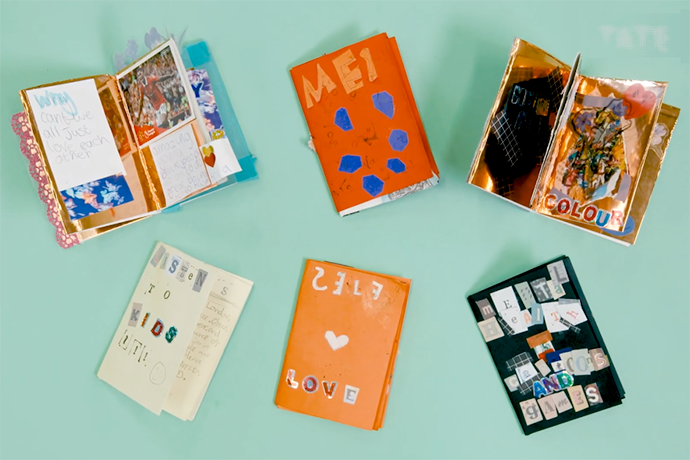Welcome to this Wednesday email! This week I wanted to continue both the Summer Projects theme and the Computing Unplugged projects in last week’s email. Not all STEM/STEAM stuff has to involve technology. 🙂
This week the Summer Project is how to create a zine, a short 2-4+ page publication that you can make out of printer paper. The hardest part may or may not be to come up with an idea for content. But kids are inventive. And a zine is a simple hands on way to express themselves. Hopefully you’ll find it fun too.
Summer Projects: Creating Zines
The word “zine” is short for magazine, as in the last four letters of the word (maga-zine, get it?). Where publications tend to be formal affairs with lots of people, deadlines, printing, and distribution problems to solve, zines are a matter of folding paper into pages and then writing and drawing on each page. Zines have been around for a very long time. They’re often very creative. And fun to read because their creators are passionate about the topic of their zine.
And no worries if you or a kid in your life wonders what to create. Zines can be about anything: your favorite food (cookies?!), music, flowers, pets, colors, things that happened to you, what you’re doing this summer, and so much more.
These links can help you get started folding paper and then creating a zine about whatever interests you. Also, as the person in the Tate Museum video says, “Messy is good.”
How to Make a Zine
https://www.tate.org.uk/kids/make/cut-paste/how-to-make-a-zine
https://www.youtube.com/embed/AAyYHMldD_0
Learn How to Make Your Own Zine
https://www.youtube.com/embed/C8zP7wbwyt8
How to Make a Zine: A Kid-Friendly DIY Guide
https://www.readbrightly.com/how-to-make-zine/
Creative Writing For Kids: Making Zines!
https://www.youtube.com/embed/nAlZ2nR3Qkw
25 “Create Zine” Ideas & Tips for Everyone
https://publuu.com/knowledge-base/25-amazing-zine-ideas/
Zine History
https://www.slideshare.net/sardonicsmile/zine-history
Zines for Kids
https://www.zinelibraries.info/zines-for-kids/
Whatcha mean, what’s a zine? : the art of making zines and minicomics
https://search.worldcat.org/title/836092872

Flying Cars
Would you like a car that flies? Well, they actually exist. They don’t drive on roads but the Jetson Aero is a single person vehicle that you can fly. It can reach speeds of 63 miles per hour and fly for about 20 minutes with a pilot who weighs 187 pounds. (If you don’t know, flying is a lot about managing weight, fuel, and distance traveled.) In the case of the Jetson Aero, the fuel is electricity. Check out these videos and their YouTube page.
Here’s something interesting to think about: how would rush hour traffic on roads with lanes translate to flying cars and open skies? Do you want hundreds or thousands of cars flying over your house or apartment building at all hours of the day and night? While you might be able to get rid of roadways, how would you avoid crashes? The technology is definitely exciting. And fun. But there’s lots of problems to work out.
Jetson Website
https://jetson.com/
https://www.youtube.com/embed/FzhREYOK0oo
Jetson YouTube Page
https://www.youtube.com/channel/UCJNoPkgW0KSKzBHgFJ3VRtQ
15 Unique Flying Machines
https://www.youtube.com/embed/a6SQsAoDjH4
Polynesians and Binary Numbers
It’s too easy to believe that our world is unique compared to past societies. However, people have had the same problems regardless when they were or are alive: how to find and make food, clothing, and shelter at the least. Of course, counting and math has been a critical need for all societies. Turns out the Polynesian culture, mostly isolated out in the vast Pacific Ocean, developed a binary number system to help with solving problems. Centuries before Europeans figured out how to use binary numbers.
Polynesian people used binary numbers 600 years ago
https://www.nature.com/articles/nature.2013.14380
Binary Numbers
https://kidscodecs.com/binary-numbers/
Binary Numbers
https://en.wikipedia.org/wiki/Binary\_number
The Hungry Camel
I love recreational math puzzles. This one is from England around 800 AD, one of many math puzzles reportedly created by Alcuin, one of Charlemagne’s teachers:
A certain head of household ordered that 90 measures of grain be taken from one of his houses to another 30 leagues away. This load of grain can be carried by a camel in three trips. Given that the camel eats one measure of grain for each league it goes (the camel only eats when carrying a load), how many measures were left after the grain was transported to the second house?
The beanz magazine article describes how to work through the problem to solve it. And no worries, the camel gets fed.
The Hungry Camel
https://kidscodecs.com/the-hungry-camel-math-problem/
Propositiones ad acuendos iuvenes by Alcuin
https://mathshistory.st-andrews.ac.uk/HistTopics/Alcuin\_book/
Alcuinundrums: Seven brain teasers from the early Middle Ages
https://thijsporck.com/2016/06/05/alcuinundrums/
Alcuin of York
https://en.wikipedia.org/wiki/Alcuin
This Week
Our Sunday issue this week is for paid subscribers. It will have fun often offbeat links about ancient solar eclipses, whether or not our sun is conscious, how brain waves are different, a pacemaker powered by light, an origami computer, and more.


